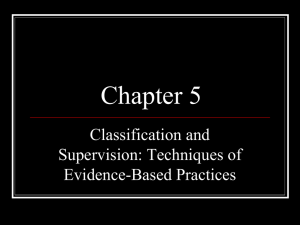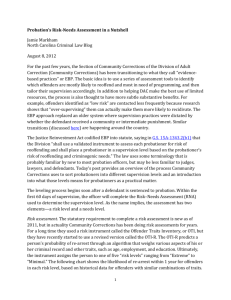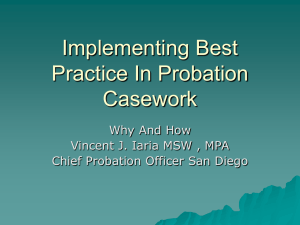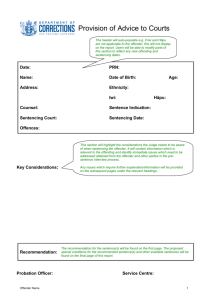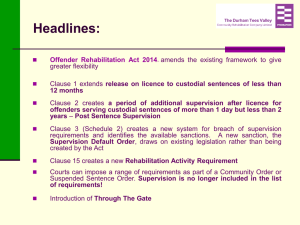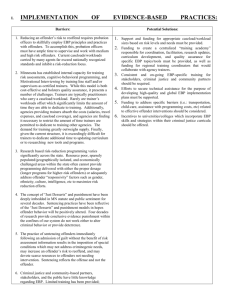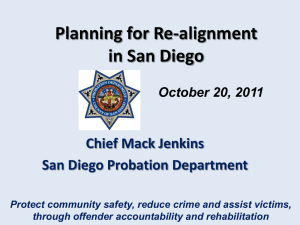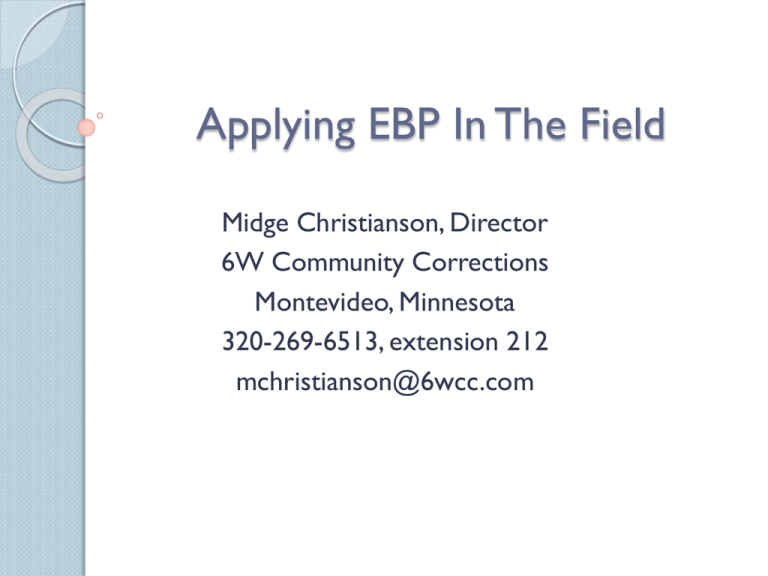
Applying EBP In The Field
Midge Christianson, Director
6W Community Corrections
Montevideo, Minnesota
320-269-6513, extension 212
mchristianson@6wcc.com
6W Community Corrections
4 counties
3,000 square miles
Community Corrections Act Agency
Incorporating EBP in the trenches:
What has changed?
How did we change?
1970 - 2000
“THE LAY OF THE
LAND”
1974 Robert Martinson Study
“NOTHING WORKS”!
Study drove practices through the
1980’s and 1990’s
Focused on deterrence through
incarceration or “offender management
techniques”
“Just desserts” and “crime control”
What that looked like in 6WCC…..
Many states developed determinate
sentencing guidelines during this time
Group of criminologists/researchers
continued to study offender change
Discovered we can predict risk of future
criminal behavior based on factors
Discovered “what works” in changing
offender behavior
Discovered what doesn’t work (stop it!)
Discovered some practices INCREASE
the risk of criminal behavior – (stop that
too!)
EBP PRINCIPLES
Assess risk and criminogenic needs
Enhance intrinsic motivation
Target interventions
Skill train with behavioral directed
practice
Increase positive reinforcement
Engage ongoing support in natural
communities
Measure relevant practices
Provide measurement feedback
PRINCIPLES AND PRACTICE
ARE TWO DIFFERENT
THINGS!
PRACTICE
Changed WHO we supervise
Changed HOW we supervise
Change WHAT we supervise
Changed HOW LONG we supervise
WHO
Target interventions on medium and high
risk offenders
Assess risk AND criminogenic needs
Worked with Judiciary
Eliminated supervision of low level offenses
– traffic, shoplifting, bad checks, juvenile
curfew and smoking
Resource focused – who do you want us to
spend our time on?
Judge Paul Nelson: “We’ve gotten rid of a
lot of supervised matters and the world
hasn’t come to and end”.
HOW
Target interventions on medium and high
risk offenders (supervision continuum)
Enhance intrinsic motivation (motivational
interviewing, effective alliance)
Supervision Continuum
Target supervision resources on medium and
high risk offenders
Risk assessment tools – Level of Service
Inventory Revised (Level of Service/Case
Management Inventory), Spousal Assault Risk
Assessment, Sex Offender Specific tools
Administrative, group supervision, traditional
supervision, general enhanced supervision,
sex offender enhanced supervision
Low/Medium Low Risk
Very limited exposure to system
Developed IN CONSULTATION with
Judiciary, Prosecution, Executive Board –
expectations agreed upon by all
Misdemeanor DWI, misdemeanor
property
No general probation conditions, monitor
special conditions only, then discharge
Group supervision
Medium High/High Risk
Specialized caseload for sex offenders and
general enhanced
Lower caseload size to allow more faceto-face contact
Progressive phases and a focus on
criminogenic needs/case planning (versus
surveillance)
MOTIVATIONAL INTERVIEWING
EFFECTIVE ALLIANCE
MI: “A collaborative, person-centered
form of guiding to elicit and strengthen
motivation to change.”
Effective Alliance – the quality of the
agent/offender relationship can positively
impact the outcome of probation and
recidivism. Crucial for agents to be able
to cultivate relationships with offenders
that maximize the likelihood of success.
WHAT
Target interventions on identified
criminogenic needs specific to each
offender that can be changed
Skill train with directed practice –
cognitive skills group
What has been proven to work rather
than what sounds, looks or feels good
Focus the purpose of offender contact
more on criminogenic needs than
reviewing conditions of probation
EXAMPLES
Information regarding risk assessment
score by domain/criminogenic needs in
PSI’s and violation reports,
recommendations tied to needs
Removed “obey all laws” from general
conditions of probation. Judges specify IF
and WHAT TYPE of OBAL condition.
No standard abstain/random testing
condition – based on identified risk per
assessment(s)
EXAMPLES CONTINUED
Financial matters/monitoring moved to
Court Administration
22 week Cognitive Skills Course
Agents trained in Cognitive Skills
principles
Content/quality of contacts is stressed,
not just quantity (weekly plans structure
40%-70% of time, agenda setting)
HOW LONG
Increase positive reinforcement (carrot
works better than the stick)
Worked with Judiciary and Prosecution to
develop standards and common
expectations
Incentive of early discharge for all offense
types except sex offenses
Reward offenders for compliance by
decreasing supervision level (phases on
enhanced caseloads; group supervision)
Restructure Process – work with
offender to address issue rather than
violate
CHALLENGES
Last two EBP principles: Measurement
and Feedback/Modification
Quality Assurance and Fidelity
Keeping current on new research and EBP
Resources


